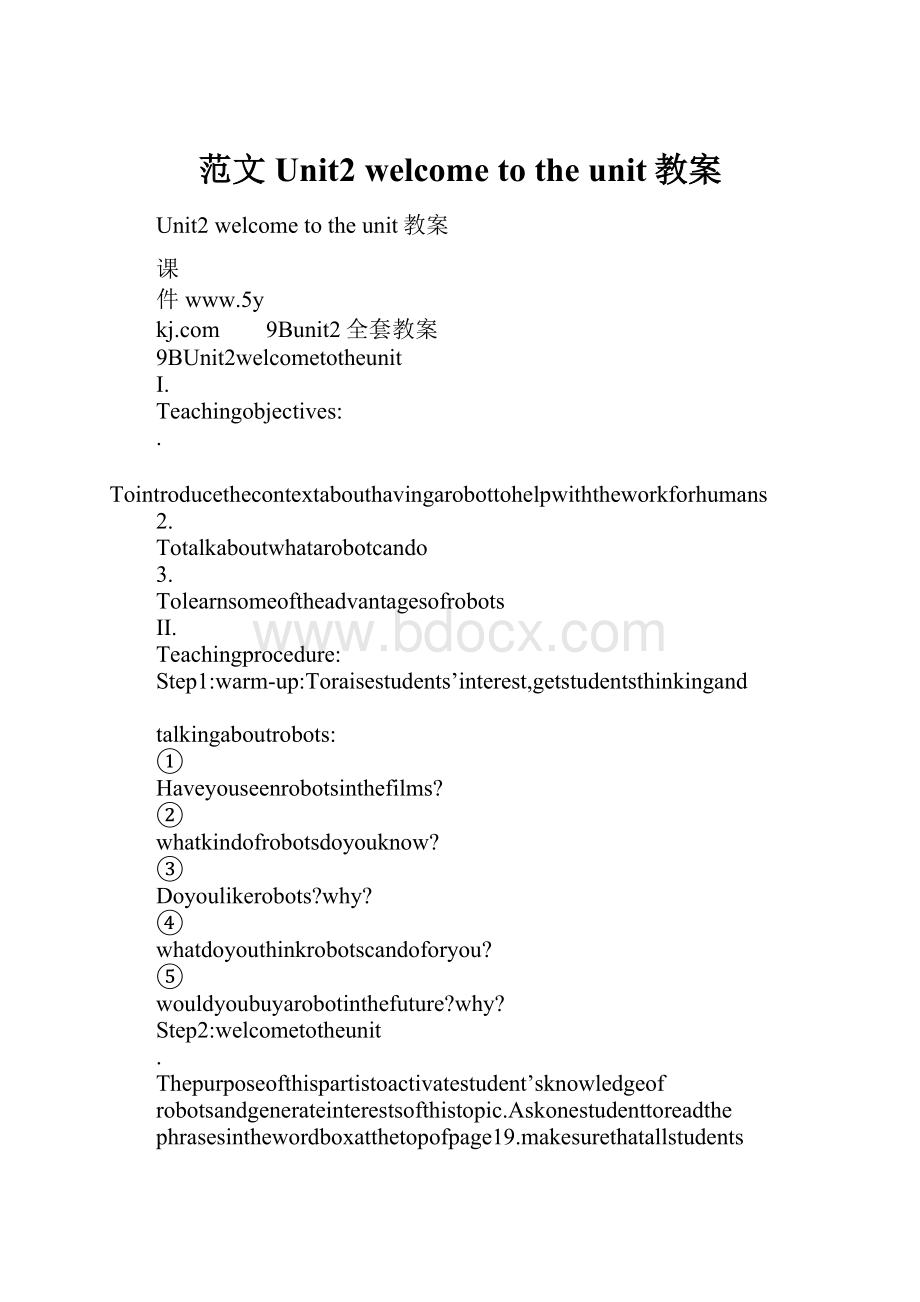范文Unit2 welcome to the unit教案.docx
《范文Unit2 welcome to the unit教案.docx》由会员分享,可在线阅读,更多相关《范文Unit2 welcome to the unit教案.docx(14页珍藏版)》请在冰豆网上搜索。

范文Unit2welcometotheunit教案
Unit2welcometotheunit教案
课
件www.5y
9Bunit2全套教案
9BUnit2welcometotheunit
I.
Teachingobjectives:
.
Tointroducethecontextabouthavingarobottohelpwiththeworkforhumans
2.
Totalkaboutwhatarobotcando
3.
Tolearnsomeoftheadvantagesofrobots
II.
Teachingprocedure:
Step1:
warm-up:
Toraisestudents’interest,getstudentsthinkingand
talkingaboutrobots:
①
Haveyouseenrobotsinthefilms?
②
whatkindofrobotsdoyouknow?
③
Doyoulikerobots?
why?
④
whatdoyouthinkrobotscandoforyou?
⑤
wouldyoubuyarobotinthefuture?
why?
Step2:
welcometotheunit
.
Thepurposeofthispartistoactivatestudent’sknowledgeof
robotsandgenerateinterestsofthistopic.Askonestudenttoreadthe
phrasesinthewordboxatthetopofpage19.makesurethatallstudents
understandthemeaningsofthephrasessuchas‘dothelaundry,explorerdangerousplaces’intheirownwords.
2.Explainthecontext.DanielisexplainingtoAmywhatrobotscan
do.AskstudentstocompletetheconversationonPage19ontheirown.
3.
Asktwostudentstoreadtheconversationandcheckmistakes.
4.
Encouragestudentstotalkaboutifrobotsareharmful?
Divide
studentsintogroupstodiscuss.
①
whatdorobotsdoharmtohumanbeings?
②
whydotheydoharmtohumanbeings?
5.
Listentothetapeforthefirsttimetolearnthemainideaof
thecomicstrip.
6.
Listentothetapeforthesecondtimetoreadafterthetape.
7.
Asksomestudentstoactoutthecomicstrip.
Step3:
Usefulexpressions
.complaint:
不+可数名词“抱怨”;可数名词“抱怨的行动或话,投诉”
complain:
动词:
complainto/about
2.
post:
动词‘邮寄’:
.postsomethingforsb.
III.
Homework:
.
Recitetheusefulvocabularyandcomicstrip.
2.
completesomeexercise.
3.
Previewreading
教学小结:
学生基本能掌握对话,理解机器人能为人类做好多事。
要求学生进行会话,课后学生都能背诵对话。
9BUnit2Reading
I.
Teachingobjectives:
.
Tounderstandtheideaofhowrobotscanchangeourlives.
2.
Torecognizeandunderstandvocabularyaboutlifewithrobots.
3.
Toidentifythegoodpointsofowningarobot.
II.
Teachingprocedure:
Step1:
Backgroundinformation:
Arobotisanautomatedmachinethatis
programmedtoperformfunctionsjustasahumanwoulddo.
Step2:
Reading“Thefirstpersontoownarobot”
.
Reviewthethingsthatarobotcandoin“welcometotheunit”.
Askstudentswhethertheybelievepeoplewilluserobotstodotheir
choresfortheminthefuture.
2.
Explainthecontextofthereadingpassage.Danielisreadingan
articleabouthavingarobotathome.Therearegoodpointsandbad
points.
3.
Askstudentstolistentothepassage,payingattentiontothe
pronunciation,andmakesomeofthemtoreadtheparagraphsaloud.
4.
Listthegoodpoints.
5.
Askstudentstoreadeachparagraphandputforwardquestionsif
theyhave.
Step3:
languagepoints
.
thefirstonetodosth.
2.
inorderto:
引导目的状语,后接动词原形,可以放在句首,或句末,否定形式inordernottodosth.:
ShelistenstoEnglisheverydayinordertogetgoodmarks.
=soastodo:
ShelistenstoEnglisheverydaysoastogetgoodmarks.
=inorderthat+从句:
ShelistenstoEnglisheverydayinorderthatshecan
getgoodmarks.
=sothat:
ShelistenstoEnglisheverydaysothatshecangetgoodmarks.
3.
asaresult:
“因为,由于,由于。
。
。
结果”,用来做结果状语
Shewaslateasaresultofheavyrain.
4.
nolonger:
“不再,再也不,今后不再“,指时间,多由于修饰某种具体状态,相当于notanylonger,其中any
longer一般放在句末。
Inolongergothere.=Idon’tgothereanylonger.
There’snomorewater.=Thereisnotwateranymore.
5.
foranextrahour:
extra“额外的,附加的”
III.
Homework:
.
Recitetheusefulvocabularyandparagraphs.
2.
completesomeexercise.
3.
Previewreading
教学小结:
了解机器人如何改变我们的生活,掌握课文里的语言点和重点。
以及机器人给我们带来的好处。
9BUnit2Reading
I.
Teachingobjectives:
.
Toidentifythebadpointsofowningarobot.
2.
Toidentifytrueandfalsestatementsaboutlifewitharobot.
II.
Teachingprocedure:
Step1:
Revision:
Revisetheusefulexpressionsagainorallyandhavea
dictation.
Step2:
Reading“Thefirstpersontoownarobot”
.Explainthecontextofthesecondpartofthereadingpassage.
Danielisreadinganarticleabouthavingarobotathome.Therearebad
points.
2.
Askstudentstolistentothepassage,payingattentiontothe
pronunciation,andmakesomeofthemtoreadtheparagraphsaloud.
3.Listthebadpoints.
①
catchavirusandcausealotofproblems
②
nolongerknowwhentocookandwakemr.jiangupat4inthe
morning.
③
Findhisbreakfastinthewashingmachine,cleanshirtsinthe
dustbin,booksinthesink.
④
movearoundthehouseandknockthingsover
4.
Askstudentstoreadeachparagraphandputforwardquestionsif
theyhave.
Step3:
languagepoints
.
behappywith=besatisfied/pleasedwith
2.
wakesb.up
3.
intheend=atlast=finally
4.
returnsth.tosb.=givesth.backtosb.
5.
decidetodosth.
III.
Homework:
.
Recitetheusefulvocabularyandparagraphs.
2.
completesomeexercise.
3.
Preview“Vocabulary“
教学小结:
了解第一个拥有机器人的人以及机器人给他带来的坏处。
这一课时结实以后要求学生背诵课文。
提高学生的口语能力。
9BUnit2Vocabulary
I.
Teachingobjectives:
.
Tolearnthenamesofdifferentpartsofarobot.
2.
Todesignanidealrobot
3.
Towriteanarticletodescribetheidealrobot.
II.
Teachingprocedure:
Step1:
Inweakerclasses,studentsprobablywillnotknowwhatsomeof
thewordsinPartAmean.writethewordsontheblackboardandhelpthem
finishthepart.
e.g.:
what’stheuseofacamera/battery/hand/wheel/speaker?
Acameratakespictures.
Abatterygivesuspower.
Ahandhelpspickupthings.
wheelshelpthingsmove.
wecanhearsoundthroughaspeaker.
Step2:
Showstudentsrobotpicturesandaskstudentswhatotherfeatures
arobotmighthave.ThiswillhelpstudentswithPartB.Encourage
studentstousetheirimagination.
①
Askstudentstolookatthepictureonpage24andanswerthe
questions.
②
Askstudentsquestionsaccordingtothepicturesshown:
whatdoesitlooklike?
whatisthereonthehead/intheface/onbothsidesofitsbody?
Howdoesitspeak?
whatistheuseofthearms/hands?
Howdoesitmove?
whatkindofenergydoesithave?
Step3:
Explainthecontextofpartb.Danieliswritinganarticleto
describehisidealrobot.Havestudentsworkinpairsandcompletethe
exercise.
Step4:
Askvolunteerstoreadthecompletedarticlefortheclass.check
formistakesandmispronunciations.
III.
Homework:
.
PreviewGrammar1
2.
completesomeexercises.
教学小结:
了解机器人的各部分零件。
以及各部分零件的用处。
帮助差一些的学生能更好的理解
它们的意思,把单词写在黑板上,使他们更好的掌握。
9BUnit2Pronunciation
I.
Teachingobjectives:
.
Tounderstandtheuseofstressinsentences
2.
Torecognizethedifferentmeaningsofasentencebasedonwhere
thestressisplaced
3.
Tostresstherightwordsinasentence
4.
Tochoosethecorrectmeaningsofasentencebasedonstressed
words.
II.
Teachingprocedure:
Step1:
Readthethreeexamplesentencesclearlyandslowlyforstudents
tolistento.Askstudentstorepeatsentenceafteryoupayingattention
tothewordsthatisstressed.
Step2:
PlaytherecordingforpartAthroughonceandaskstudentsto
listencarefullytothestressedwords.
Step3:
Playtherecordingagainandencouragestudentstoimitatewhat
theyhear.Askstudentstoreadthesentencesaloud.
Step4:
Explainhowthestressedwordsaffectthemeaningsofthe
sentences.
Step5:
Dividetheclassintopairs.Askstudentstoreadoutthe
sentencestoeachother,stressingthewordsinbold.Listentothe
sentencesasyouwalkaroundtheclass.Praiseareaswherestudents
performwell.
Step6:
Explainthatwhenwespeak,wecanstressdifferentwordsina
sentence.Thewordswestresscanchangethemeaningsofthesentence.
writeanexamplesentenceontheblackboard:
“Thedogatefourtinsofbeansyesterday.”
①
whoatefourtinsbeansyesterday?
②
Howmanytinsofbeansdidthedogeatyesterday?
③
whatdidthedogeatfourtinsofyesterday?
④
whendidthedogeatfourtinsofbeans?
Step7:
ReadthetwosentencesinpartBaloud,stressingthewords“robot
andDaniel”.
Step8:
Askstudentstoreadpointsa,bandcundereachsentence.Ask
themtocircletheletterwiththecorrectmeaningsforeachone.
Step9:
Asktwostudentstoreadouttheirchoices.Encouragestudentsto
raisetheirhandsiftheydonotunderstandwhytheseanswersarecorrect.
III.
Homework:
.
Previewmaintask.
2.
completesomeexercises.
教学小结:
能理解句子重音的使用,学生在听了一遍后能读出句子的重音。
9BUnit2Integratedskills
I.
Teachingobjectives:
.
Toextrainformationfromaposter.
2.
Tocompletenotesaboutarobotexhibition
3.
Toextractinformationfromaradioprogramme
4.
Tocompleteane-mail
5.
Totalkaboutwhatrobotscandoandgiveopinionsabout
differenttypesofrobots.
II.
Teachingprocedure:
PartA:
Therobotexhibition
Step1:
Askstudentswhethertheyhaveeverbeentoanexhibitioncenter
andwhatexhibitionstheyhaveseenbefore.
Step2:
Explaintostudentsthattheywillnotbeabletofindallthe
informationtheyneedtocompletethenotesinPartA1justfromreading
theposter..However,theyshouldtrytofindasmuchinformationasthey
can.
Step3:
Tellstudentstheycancompletethenotesbylisteningtothe
radioprogramme.
①
Listentothetapeforthefirsttimetogetitsmainidea.Explain
thewords:
japan,Southkorea,language,memory.
②
Listentoittofindthenecessaryinformationtheyneed.
③
Playtherecordingwithoutstopping
④
Askstudentstogivetheirownanswers.
⑤
checktheanswerwiththeclass.
⑥
Playtherecordingagain,allthewaythrough,withoutstoppingso
thatstudentscanchecktheirownanswers.
Step4:
ExplainthecontextofpartA3.Remindstudentstheycanreferto
theinformationonpage28tofillintheblanks.
Step5:
Encouragestudentstocompletethisexerciseontheirownorin
groups.
PartB:
Speakup.
Step6:
Askstudentstoworkinpairs.Theyshouldreadtheconversation
throughonce,swaprolesandthenreadtheconversationagain.
Step7:
Encouragestudentstomakeuptheirownconversationsabout
robots.Listentothestudents’asyouwalkaroundtheclassroom.Asksome
pairstopresentnewonestotheclass.
III.
Homework:
.
Recitetheconversationonpage29andcompletesomeexercises.
2.
Previewpronunciation.
教学小结:
学生基本能听懂A1,A2,在听的基础上完成A3.了解国际展览上不同国家的机器人。
学生在学的同时能互相对话,谈论机器人能为我们做些什么。
9BUnit2Grammar
I.
Teachingobjectives:
.
Touseobjectclausesintroducedby“wh-“words
II.
Teachingprocedure:
Step1:
Reviewobjectclausesintroducedby“iforw